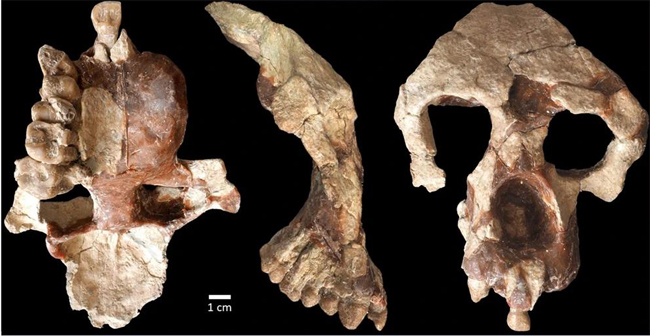Fossils of an ancient ape that lived in Turkey around 8.7 million years ago is challenging accepted ideas about human origins. The fossils include skull bones, jaws and teeth of both males and females. This new ape has been named Anadoluvius turkae. The material was excavated from the Çorakyerler fossil locality near Çankırı in northern Turkey, about 60 miles (100 km) northeast of the country’s capital, Ankara. Assigned to the subfamily Homininae, the genus name is from “Anadolu” the modern Turkish word for the Anatolia region.
The discovery of A. turkae lends support to the hypothesis that the Homininae first evolved in Europe before migrating to Africa 7–9 million years ago.

The subfamily Homininae consists of two tribes. The Hominini which includes modern humans and their extinct relatives along with the subtribe Panina which consists of bonobos and chimpanzees. In addition, there is the Gorillini tribe (gorillas).
Anadoluvius turkae
The researchers suggest that hominines (members of the Homininae tribe), not only evolved in western and central Europe but spent over five million years evolving there and spreading to the eastern Mediterranean. These apes eventually dispersed into Africa, probably as a result of a drying climate reducing the amount of forest habitat in the eastern Mediterranean.
The well-preserved fossils including an Anadoluvius cranium permitted the scientists to conduct a detailed analysis of character attributes in the fossil record. This new study supports the hypothesis that hominines originated in Europe and dispersed into Africa along with many other mammals between 9 and 7 million years ago (Tortonian stage of the Miocene Epoch).
Anadoluvius turkae was about the size of a modern chimpanzee. Anadoluvius probably weighed around 50-60 kilograms. It inhabited dry forested habitats and probably spent a lot of time on the ground rather than in the trees.
More Miocene Homininae Fossils
The researchers consisting of scientists from Ankara University, Pamukkale University and the Ege University Faculty of Science (Turkey), along with colleagues from the Naturalis Biodiversity Centre (Holland) and the University of Toronto (Canada) hope to find more fossils.
A spokesperson from Everything Dinosaur commented:
“Further fossil discoveries will help to clarify the evolutionary origins of the Homininae. More fossils from Africa and Europe will help palaeontologists to outline the geographical distribution of our ancient ancestors.”
Everything Dinosaur acknowledges the assistance of the Media Relations team at the University of Toronto (Canada) in the compilation of this article.
The scientific paper: “A new ape from Türkiye and the radiation of late Miocene hominines” by Ayla Sevim-Erol, D. R. Begun, Ç. Sönmez Sözer, S. Mayda, L. W. van den Hoek Ostende, R. M. G. Martin and M. Cihat Alçiçek published in Communications Biology.
Visit the Everything Dinosaur website: Visit Everything Dinosaur.






Leave A Comment